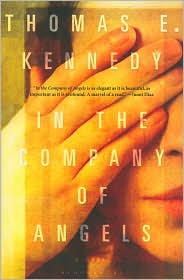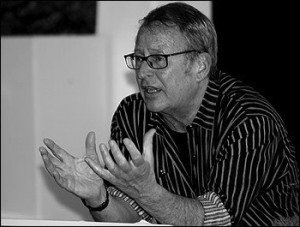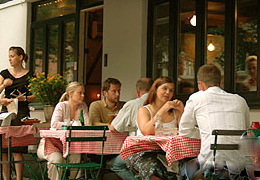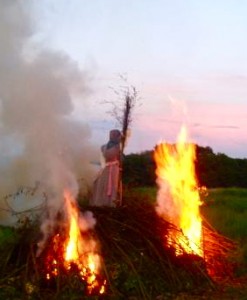Note: Thomas E. Kennedy was WINNER of the Expatriate Writing Award in 2002, his citation saying, “Kennedy has done for Copenhagen what Joyce did for Dublin.” This book, originally published in Ireland as Greene’s Summer (and now edited and expanded into a new novel), was WINNER of the 2007 Eric Hoffer Award for books from independent publishers.
“How much of a survivor, in fact, survives? How much must remain of a survivor for him also to be called a man? Some of us who are still present and accounted for perhaps are desaparecido nonetheless, invisible pieces missing from the whole. You tell me to remember… Perhaps there is nothing left …Perhaps it is all gone. Perhaps all that is left is the screaming. Empty screaming to fill empty ears.”
It is diff icult to know even where to begin in reviewing this novel, a novel so broad in its themes and scope and so sensitive to the details which make it come alive that other American readers, like me, will undoubtedly be waiting as impatiently as I am for the rest of the novels which make up the “Copenhagen Quartet.” Author Thomas E. Kennedy is an expatriate, born in New York, who has been living in Copenhagen for many years, and though he has achieved remarkable success in Europe, and has won many prizes there for his twenty novels, his work has not been readily available in the United States–until now. This novel deserves wide readership and will appeal to readers from around the world who care about the right of all humans to live freely, able to speak their minds, even when they disagree with the current governments of their countries.
icult to know even where to begin in reviewing this novel, a novel so broad in its themes and scope and so sensitive to the details which make it come alive that other American readers, like me, will undoubtedly be waiting as impatiently as I am for the rest of the novels which make up the “Copenhagen Quartet.” Author Thomas E. Kennedy is an expatriate, born in New York, who has been living in Copenhagen for many years, and though he has achieved remarkable success in Europe, and has won many prizes there for his twenty novels, his work has not been readily available in the United States–until now. This novel deserves wide readership and will appeal to readers from around the world who care about the right of all humans to live freely, able to speak their minds, even when they disagree with the current governments of their countries.
Main character Bernardo (Nardo) Greene, an “ordinary” Chilean school teacher, was tortured for two years during the Pinochet government because he varied from the assigned curriculum in order to expand the minds of his students. Through him, Kennedy takes a close look at Chile during the Pinochet government (1973 – 1980). He also, however, examines the similarities between government-sanctioned (and encouraged) torture there, which brought the victims close to death before they were suddenly revived (if they could be revived), and other forms of torture, including spousal abuse, the repression of women, and the inaction of people who might, with stronger commitments, have changed the course of history if they had listened to their consciences and challenged authority.

Ostensibly a love story between Nardo, a widower whose wife and son were “desaparecido” during his incarceration and torture, and Michela Ibsen, a forty-year-old Danish woman whose ex-husband abused her and whose seventeen-year-old daughter committed suicide, the novel examines many themes related to love and death, freedom and forced confinement, and the worldly and the spiritual. Green is getting treatment in Copenhagen at a center devoted to the rehabilitation of torture victims, so traumatized that he is unable to look at his Chilean imprisonment with any kind of objectivity. He wonders if he will ever be able to trust a human again. His nightmares about “Frog-eyes,” his torturer, still haunt him. His psychiatrist, Thorkild Kristensen, dedicated to Nardo’s recovery, has his own problems.

Cafe Bopa
When Nardo and Michela meet, she has just told her younger lover, Voss, that she will not tolerate his recent instance of abuse. She sees him as too immature to know what love is, but she also recognizes that she, herself, is also naive, a woman who has been abused to the point that she no longer understands what it is to love. As the story of Michela and Nardo unfold, each is reluctant to make any commitment, fearful that the past will impose on the present and end the budding love that is unfolding. The reader becomes totally consumed with the stories of these characters, hoping for their happiness at the same time that s/he recognizes their personal limitations.
Kennedy’s novel is not “just” a love story. Nardo has survived his torture because at the moment that he might have given up, he is visited by angels who take him out of his imprisonment long enough to show him a happier life, telling him that though he has to return to his prison, that he will one day be free. Throughout his time in Copenhagen, Nardo notices birds and feeds them, the symbol of freedom and escape from the earth’s limitations; the rain is cleansing. Music and dance become a major pleasure and memory for him.

Midsummer Night's Eve burning of witches, traditional in Denmark
Every detail here is completely integrated into the thematic structure of the novel, with symbols adding to the novel’s power and involving the reader on new levels. Even the location of the cafe where Nardo dances the tango with Michela, Cafe Bopa, is the site where the Gestapo executed Danes who challenged the German occupation during World War II. How seemingly civilized human beings can torture and kill and enjoy it, becomes a major question during the course of the novel, at the same time that the author is examining the meaning of love and how to achieve it. Elegant, subtly constructed so that every level expands the themes, and beautifully descriptive of Copenhagen and its surroundings, In the Company of Angels is a book so good that it is hard for me to imagine another book displacing it from the top of my Favorites for 2010.
Notes: Also by Thomas E. Kennedy: FALLING SIDEWAYS, KERRIGAN IN COPENHAGEN , BENEATH THE NEON EGG
The author’s photo by Finja Desler is from http://www.washingtonpost.com/wp-dyn/content/article/2010/03/19/AR2010031901397.html
The photo of the Cafe Bopa, the real place where Nardo and Michela met and did the tango, is from www.cafebopa.dk. Bopa is the location where the Gestapo executed Danes who challenged the Occupation.
The burning of straw witches, which takes place in this book, is traditional in Denmark during Midsummer Night’s Eve. This photo is from Wikimedia.
During the novel, Nardo listens to the music of Finnish composer Rautavaara, “Angels and Visitations.” Brief samples of this music are available on Amazon: www.amazon.com
A video interview with the author appears here: www.amazon.com
